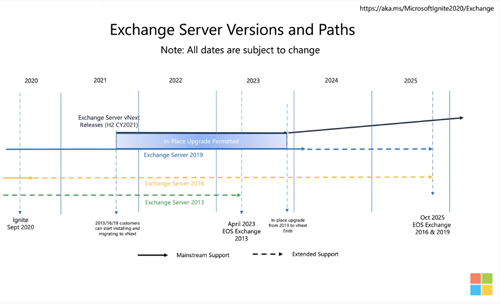News
Microsoft To Switch to Subscription Model for Some Server Products
- By Kurt Mackie
- October 01, 2020
New application server products coming from Microsoft in the second half of 2021, namely "Exchange Server, SharePoint Server, Skype for Business Server and Project Server," will be offered only on a subscription basis.
Microsoft announced the move last week in an Exchange Teams post and in at least one Ignite session. While the aforementioned products will be delivered via subscription-based licensing models, perpetual licensing will still be available on the Office software side. According to the post, "new perpetual-release" Office products for both the Windows and Mac platforms will arrive "in the second half of 2021." The announcement lacked other details, however.
Online Services Subscriptions
Subscription-based licensing is typically reserved for Microsoft's services software, which gets hosted by Microsoft on its own datacenter infrastructure. Exchange Online, SharePoint Online, Microsoft Teams and Project Online are all services where Microsoft controls the software installation, patching and software lifecycles.
Subscription-based licensing gets offered via month or annual payments. If not renewed, organization can still access their data, but they can't modify it.
Microsoft's subscription-based services also typically follow the so-called Modern Policy lifecycle support model, instead of the more traditional Fixed Policy for customer premises-installed server products. The Fixed Policy offers 10 years of patch support divided into two five-year phases ("mainstream" and "extended"). The Modern Policy doesn't offer much in terms of lifecycle support assurances. At best, customers are promised an alert to major product changes 30 days in advance under the Modern Policy.
Further information about this switch wasn't provided. "We will share additional details around the official names, pricing and availability of all these products later," the announcement stated.
Exchange Migration Timeline
A Microsoft Ignite session, "Exchange -- Here, There and Everywhere," now available on demand here, didn't add much more to this picture. It suggested that Exchange Server users, from Exchange Server 2013 on up, should target their migrations toward Exchange Server 2019, which has much in common with the coming subscription-based Exchange offering, dubbed "vNext."
Users of older Exchange Server products, from Exchange Server 2013 on up, will be able to move to the VNext product via "in-place" upgrades. An in-place upgrade replaces the application server bits without IT pros having to move the data first and do "wipe-and-replace" types of installations.
The following timeline, showing Exchange Server product end-of-life dates, was shown during the Ignite session:
 [Click on image for larger view.] Exchange Server product end-of-life milestones. (Source: Microsoft Ignite 2020 session)
[Click on image for larger view.] Exchange Server product end-of-life milestones. (Source: Microsoft Ignite 2020 session)
During the Ignite talk, it was explained that Exchange Server 2019 only has two years of "extended support" (instead of the usual five years). The truncated extended support phase for Exchange Server 2019 was done intentionally by Microsoft to move organizations to its vNext subscription-based product, the talk explained.
Microsoft promised in another slide during this talk that "the new version [such as, Exchange Server vNext] will be built to support long term servicing, maintenance and easy upgrades." Further details weren't described, though.
Long-term servicing is not just a Fixed Policy option. It sometimes shows up as an option under the Modern Policy for some products, where it lasts, at most, for three years.
About the Author
Kurt Mackie is senior news producer for 1105 Media's Converge360 group.